AudioCulture
The noisy library of New Zealand music
Te pātaka korihi o ngā puoro o Aotearoa
S.P.U.D.
S.P.U.D’s songs (and they were songs) were slammed down into the face of the crowd. Take that! And that! And that! they said, as front man Glen Campbell excised his inner demons with a bewildering range of guttural shrieks and psychotic half-howls and whispers that battered and enhanced his words.
Then he’d break frame, press an open hand to his forehead, stare out and over the audience into the middle distance and stand there, silent in the eye of the hurricane.
Campbell’s vocals found a ready counterpoint in the group’s other distinct voice, his old friend and musical companion Matthew Heine with his barely restrained guitar.
Although S.P.U.D. were never depressing, they were cathartic. Life’s shit dropped away in their shock-like wake.
Together they shaped a sound full of the blunt, stabbing half riffs that Black Sabbath, Scratch Acid, Jesus Lizard and Nirvana were also capable of, mated up with the sound sprawl of Sonic Youth and the anarchic edge of The Birthday Party and Butthole Surfers at their most unrestrained and threatening.
Although S.P.U.D. were never depressing, they were cathartic. Life’s shit dropped away in their shock-like wake.
The glue that held it all together and provided a deeper, almost melodic rhythmic texture, was the bass of Peter Buckton and drums of Lance Strickland, complemented by the rhythm guitar of Matthew Hyland, and later Barnaby Curnow.
Those five dressed-down guys, who moved on stage in a rough huddle that at times swayed and stepped in a weird untutored unison, altered the course of New Zealand indie music in the mid post-punk era.
It’s easier to describe why S.P.U.D. happened and examine the impact they had. There were two main streams of cultural and musical influence on the New Zealand indie community in the 1980s:
The historically informed folk, psych and pop-punk strand drawn on initially by South Island groups and those they inspired, which looked to England for approval, where a parallel indie movement existed. The diverse UK post-punk and indie scene provided another sub-strand of inspiration for the more discursive art, gothic and electronic influenced pop and experimental acts that appeared throughout the era.
A second strand of influence came hard on the former’s heels from America’s rock-cored punk and post-hardcore underground with some out-there Australian post-punk acts thrown in.
While S.P.U.D. were signed and released by Flying Nun Records, a label more readily associated with the former strand of influence, they were more clearly of the latter (although the label’s catalogue was always more diverse than the received history allowed).
One key release in particular has been overlooked in Sonic Youth’s Sister, their third album, which was made available on Flying Nun Records in 1988. This was a tacit endorsement and recognition of the similarities with the rising American indie labels and scenes of the time.
Pere Ubu were the only US group of that experimental ilk to be consistently released here in the early to mid 1980s, although such American oddities as Suicide, The Residents and the better-known (early) Devo had NZ pressings. But it wasn’t enough to allow a focused sense of rising community. That came from SST Records, the controversial Los Angeles indie that was home to hardcore punk group Black Flag.
SST Records drew in disparate groups in much the same way that Flying Nun Records did in the early to mid-1980s. The indie label had The Minutemen, Butthole Surfers and Hüsker Dü, who in turn attracted Sonic Youth and Dinosaur Jr. By the late 1980s, the two post-hardcore streams, the original groups such as Meat Puppets, Butthole Surfers and Sonic Youth, and those influenced by them, including Nirvana, had become entangled.
Few New Zealand groups had the skewed, discordant power of the Americans and S.P.U.D. became a popular support act.
It wasn’t until January 1989 that any of the vanguard appeared in the flesh. Sonic Youth played a single show at Auckland’s Powerstation in support of Daydream Nation. Supporting them that night were The Verlaines along with S.P.U.D, who were already muscling their way around Auckland venues and soon to record their debut album, Sour.
Few New Zealand groups had the skewed, discordant power of the Americans and S.P.U.D. became a popular support act, going on before Dinosaur Jr in November 1989 and Mudhoney in December the following year.
The word must have got out that there was a receptive audience in New Zealand, because in 1991, Butthole Surfers, Bob Mould, The Lemonheads and Fugazi all played in Auckland, followed in February 1992 by Nirvana. The American underground was a huge influence on New Zealand alternative music by then, as it would continue to be for the rest of the decade.
Important in the local context was the string of punk and post-punk groups who’d kept the flame alive in the mid to late 1980s. Tall Dwarfs, Children’s Hour, Headless Chickens, Flak, Y.F.C and Eight Living Legs twisted sounds and minds into different shapes. New Plymouth’s Sticky Filth broadened punk by assimilating heavy metal and hard rock textures. Auckland’s Armatrak, Bygone Era and later, Salad Daze, utilised the hard and fast directness of US Hardcore. Wellington’s Wazzo Ghoti’s chunky Fall-ish punk bore fruit on ‘Magnet’ and ‘Adder’ and Number Nine smeared prime chest-slashing Iggy all over ‘Touch and Go’ and suggested menace on Wellington streets in ‘Cop Cars’.
It’s noticeable that Flying Nun’s harder, more discordant groups, including Snapper, Straitjacket Fits, Bailterspace and Skeptics also made a bigger NZ impact as the 1980s turned to the new decade and the appeal of folk and psych-pop waned (for now).
While those sounds and participants were already in the room by 1989, it was S.P.U.D. who threw the switch that fully exposed the sea change to the wider indie public. Emerging first as Albino Slug with Glen Campbell (AKA Tyrone Slime) upfront, Luke Casey (drums), Matthew Hyland (guitar), Peter Buckton (bass) and Matthew Heine (guitar), they stepped out into a diverse Auckland scene.
Early shows in mid-1988 with Queen City punks The Warners, Bygone Era, and New Plymouth’s Casualty at Auckland University Café; and Francis Sect and Fish For Life at Rising Sun Tavern on Auckland’s K’ Road, reflected the varied local music menu of the late 1980s.
Guitarist Matthew Hyland, a talented writer, found the Auckland post-punk scene of 1988 and 1989 to be a fractured, many-limbed entity. “Stylistically they vary from Neanderthal hardcore to sparse post-Cure Pop. It’s not style that links them so much as energy and a necessary sharing of venues and audiences,” he observed in RipItUp in 1989.
In September 1988 you could find Albino Slug headlining at the new Kiwi Sounds Bar at the Station Hotel with The Honeys and The Heretics in support. October saw them back at the Rising Sun with Cuban War Poets and Weta A Go Go. Student radio mag Bifim had to stuff toilet paper in its ears before praising ‘Second Hand’ and ‘Herash’.
When ‘Herash’ eventually appeared in October 1989 on the important Ima Hitt Records compilation, Celebrate The Sonic Arts, Albino Slug had re-established themselves as S.P.U.D, with Lance Strickland replacing Luke Casey. Strickland had previously drummed with 55 Polish Workers, Grocer Man Jack and The Headshrinkers.
S.P.U.D. saw out 1988 at The Rising Sun. Regular monthly dates at the K’ Road venue, often with The Beads and Chris Knox in support, followed. In May S.P.U.D. stepped up to The Gluepot on a four band bill with The Warners, Bygone Era and Francis Sect before heading back to the Rising Sun in support of Headless Chickens the same night.
With the group recording their first album Sour at The Lab with Mark Tierney, Albino Slug’s ‘Crawling’ appeared on Onslaught Records’ Chop! Chop! Chop! compilation of Auckland indie music. More important to S.P.U.D’s progress was the impressive live capture of ‘Motorway’, a song and performance that dispelled any doubts about the group’s importance and potential. It’s on the Unloaded tape compilation, also home to tracks 'Relief’ and ‘No Home. No Shoes.’ by Clinic, a Strickland/ Campbell/ Heine side project.
With expectations still rising, Matthew Hyland left the group and was replaced by Barnaby Curnow. Hyland’s departure robbed S.P.U.D. of some of their sonic unpredictability.
After two nights at Auckland’s The Venue in September 1989, S.P.U.D headed south on The Miracle of Larnie tour. It was the group’s first national tour, taking in Eagle’s Palace in Wellington with Number Nine, and The Carlton in Christchurch with Into The Void. Further south on September 22, a thousand fans went to Sammy’s in Dunedin to see S.P.U.D. with The Verlaines and Death Ray Café.
Dunedin fanzine Alley Oop caught up with them soon after at Robert Scott’s (The Clean, The Bats) home. Under the headline “Dirtysleazyswampriddengunkmusic” (a group self description co-opted from a Radio With Pictures interview), reporter Grant McDougall found the group “getting bored” and Heine asserting that their songs were based around rhythm rather than noise.
With Sour finished but not yet released, S.P.U.D. returned to the Auckland stages. On before Dinosaur Jr with Snapper at The Powerstation on October 4, 1989, the confrontational quintet were joined by Graeme Humphries on keyboards for a version of the Able Tasmans’ ‘What Was That Thing You Said’ and ‘Motorway’.
S.P.U.D’s first bespoke record, the 12-inch single of ‘Breakdown Town’, arrived soon after, heralded by a memorable video that ratcheted up expectations for the coming album.
Heine would dispatch musical ideas across the Tasman for Campbell to match his words and vocals to, while the rest of the group carried on.
The wisdom of Glen Campbell moving to Melbourne in late 1989 had been lost on S.P.U.D’s broadening fan base, although ultimately the group weren’t greatly stymied by his change of address. Heine would dispatch musical ideas across the Tasman for Campbell to match his words and vocals to, while the rest of the group carried on practising in Auckland. The Australian scene was strong on threatening noise and diseased rock outfits and not a bad future prospect in itself. On top of that, Heine told NZ Herald that the six-month break “gave our ears a rest”.
Back in town for a national tour in late January and February 1990, Campbell finally got to hold a copy of S.P.U.D’s Sour at the LP’s release party at The Gluepot in late March. An uncompromising record with a compelling sleeve that echoed the group’s live backdrops, it snarled and snapped and took sonic swipes at the listener.
“Simple and raw” and done live with a few overdubs of vocals, guitar and piano, was how Campbell described it. A final show on April 14 at new venue the Auckland Youth Theatre, just off Aotea Square in Lower Grey’s Ave, saw them out for now.
Campbell’s absence freed the remaining band members for other projects. Matthew Heine, a talented sound engineer, recorded both The 3Ds (their first EP Fish Tales) and Into The Void in 1990 (he engineered Into The Void’s debut album in 1993). Lance Strickland joined The Osterbergs, who became Freakpower, on second guitar, while Peter Buckton also played bass in Cuban War Poets.
Meanwhile, Flying Nun Records’ new deal with Mushroom Records had put some more money in the pot and added the prospect of an Australian east coast tour to support the trans-Tasman release of Sour.
That’s what S.P.U.D. were doing in mid-August 1990 in Melbourne and Sydney, pushing product and garnering some strong media coverage. Jon Casimir in Sydney Morning Herald Metro hit the main vein of the group’s appeal:
“What SPUD specialise in is rhythm, volume and intensity, and what saves them from hard rock oblivion is their idiosyncratic love of contrast.
“Their songs whirl through jagged chords, key changes and shifting speeds, grafted onto elusive structures,” he added, noting that Campbell, “sounded permanently on the edge of panic and breakdown.”
Melbourne performances with Gravel Sandwich and Venom P. Stinger were followed by dates at Sydney’s Lansdowne Hotel with King Snake Roost (Thursday August 23), and Max’s on Friday, August 24. Then it was on to the Kardomah Café the next night with The Dubrovniks and Crow and Sunday at Harold Park Hotel with Mr Floppy.
With Campbell back in Auckland, S.P.U.D. headlined The Gluepot on September 20, 1990, returning the following night with Freakpower and Australian rockers Celibate Rifles. On December 1, they joined grunge stars Mudhoney for two nights at The Powerstation.
The thin crowd was treated to the sight of Glen Campbell sitting in a cane chair onstage, wearing sunglasses.
On the second night, the thin crowd was treated to the sight of Glen Campbell sitting in a cane chair onstage, wearing sunglasses. “I just didn’t get it,” Kirk Gee wrote in RipItUp, “it was like The Birthday Party doing heavy metal songs.”
S.P.U.D. were back in Dunedin in early February 1991, and in New Plymouth on March 9, where they teamed up with Sticky Filth and Reptiles At Dawn. They returned to The Gluepot the following week with The 3D’s and The Malchicks.
RipItUp’s Donna Yuzwalk tempted S.P.U.D. into a K’ Road hot tub for an April feature in advance of second album Gnaw’s release. “Inside a darkened room, underneath the winking pubic region of a neon sex sign, RIU were conducting an interview with SPUD,” she wrote. All but Lance were present. He had begged off, saying he, “didn’t want to sit around in a pool swimming with some old geezer’s jism.”
Amidst the bubbling water, verbal sparring and in-crowd jokes, readers learnt that Barnaby Curnow’s father was an English professor, Matthew Heine’s was a music teacher, while Glen Campbell’s father was an advertising agency executive who used to play bass in Auckland beat group The Rayders. Peter Buckton’s dad worked in a warehouse “or something”.
To listen to the Mark Tierney and Heine produced Gnaw properly, the band suggested that you “turn the bass right up, put your head through the speakers, turn out the lights, and touch yourself.”
Reviewing the record separately, Yuzwalk explained, “SPUD said the successor to Sour would be heavier and they’re right, an effect achieved in part by simply leaving out the catchy tunes that embellished Sour.”
“On Gnaw, one song bleeds into another and distinctions between tracks are not immediately discernable to the naked ear. The mood is black, pissed off (although what they are pissed off about is, as usual, a mystery).”
“However repeated listening reveals that this is in fact a carefully constructed, slow-timed noise bomb of the first order.”
“Some of us regard SPUD as a source of malevolent energy in an infuriatingly tame local music scene, purveyors of hard line dissonance without wearisome pretensions to avant-garde accessibility,” she concluded.
"Bleak, loud and relentless, coming at you with all the melodic subtlety of a lawnmower.”
And on it went: The Gluepot in May 1991 with Into The Void. Wellington and Palmerston North in July. A slot with Salad Daze before Washington DC’s impressive and deafening Fugazi, which was “everything S.P.U.D. lovers love – bleak, loud and relentless, coming at you with all the melodic subtlety of a lawnmower.”
The dark odyssey that New Zealand’s indie and alternative scene took on in the early 1990s was now fully evident. New groups kept appearing in support. Drill and Queen Meanie Puss opened for S.P.U.D. at the Gluepot in December and Auckland university students got a taste of the group in February 1992 at 95bFM’s Albert Park concert series.
Palmerston North had a busy, eventful scene of their own going when S.P.U.D joined Ethiopian Lard Farmers, Rake, Lung and K Tel Dancers for March’s Intergalactic Ball at the Albert Hotel on February 14. Manager Lisa Van Der Aarde was working them hard.
Onstage again at the trusty Gluepot with King Loser and Straitjacket Fits in April 1992, S.P.U.D. found themselves under the eye of original guitarist Matthew Hyland, who was doing for music writing what S.P.U.D. were doing for sound. “They make the listener deal with noise for its own sake, not as a supercharging of the standard rock libido,” Hyland ventured. With French horn no less.
There was one last release on Flying Nun Records, the single ‘Recliner’ (from Gnaw) b/w ‘Shitman’ and ‘Hee-ha’, before S.P.U.D. split for good in September 1992. Heine and Campbell formed Solid Gold Hell, who released several albums on Flying Nun. After his time in Freakpower, Lance Strickland drummed for King Loser. At the decade’s end, he moved to Melbourne, where he releases motorik sounds as Dot Dash.
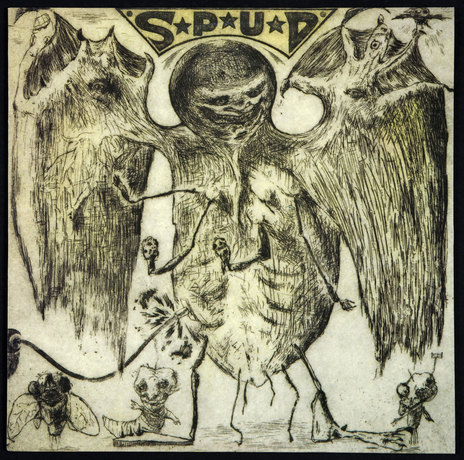
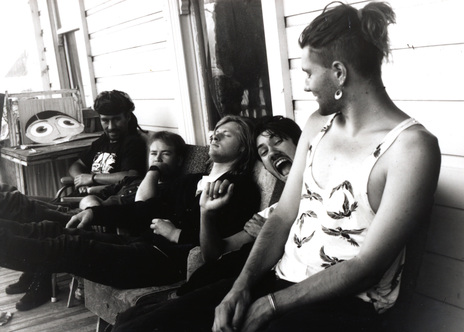
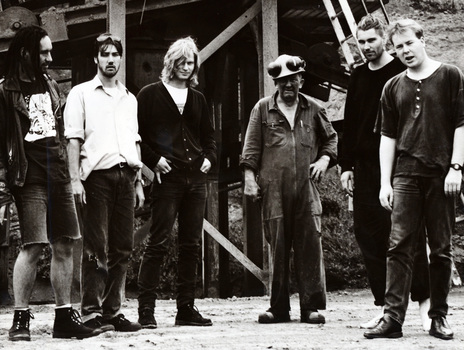
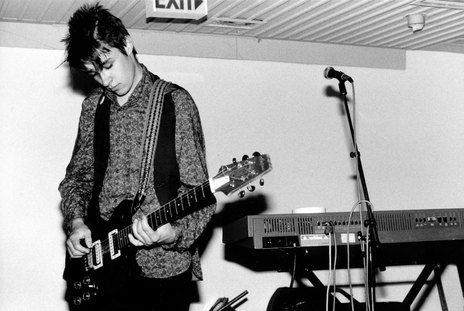
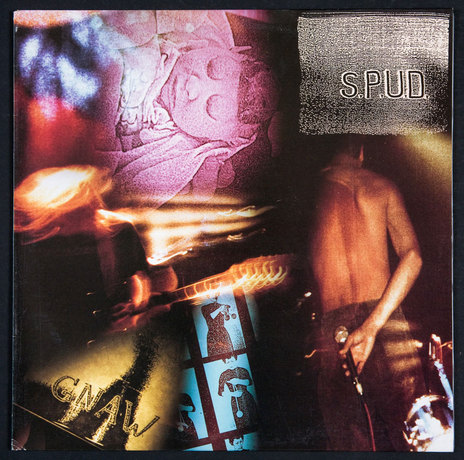
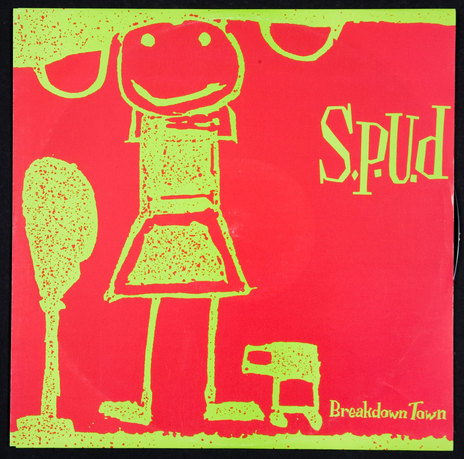
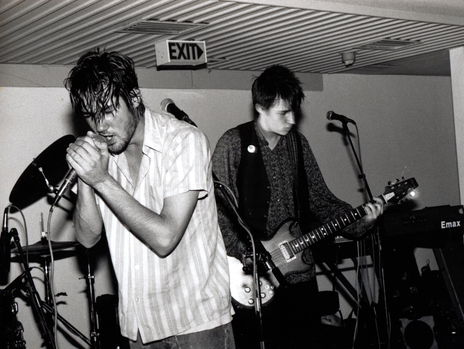
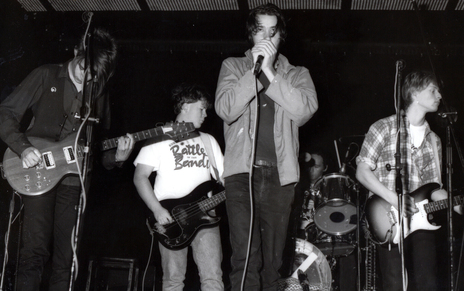
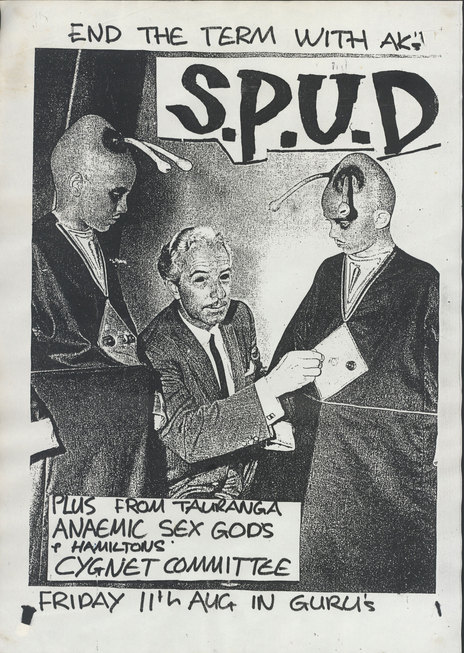
S.P.U.D. stood for the Society For The Protection Of The Unborn Dog.
The S.P.U.D. presskit described the band as "driving, threatening, killer, pounding, seething, gutteral, lurching, sleazy, swampriddengunk music".
Sonic Youth's Thurston Moore said of S.P.U.D. in 1992, "Fuckin SPUD man - whooa".
Peter Buckton - bass
Glen Campbell - vocals
Barnaby Curnow - guitar
Matthew Heine - guitar
Matthew Hyland - guitar
Lance Strickland - drums
Visit our sister site
NZ On ScreenMade with funding from
NZ On Air


